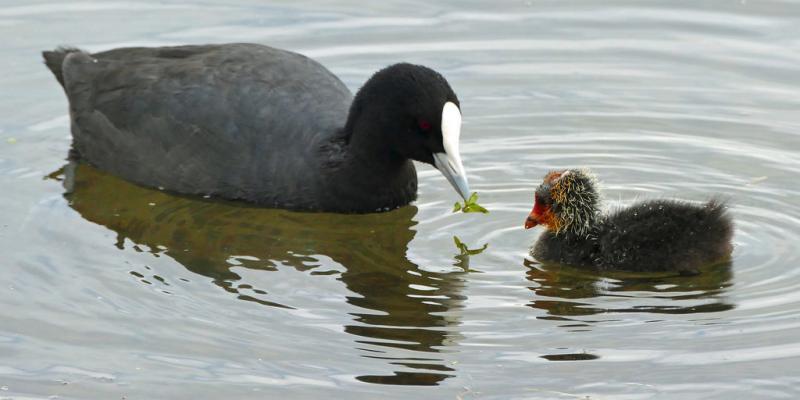Australasian Coot
Scientific Name: Fulica atra australis
Previously New Zealand had two endemic coots, both now extinct.
The coot that is now seen in New Zealand is the Australian coot, a sub-specie of the Eurasian coot (Fulica atra). This self-introduced native was rarely seen in New Zealand before becoming established in the 1950’s with the first recorded breeding taking place on Lake Hayes, Otago in 1958.
The word coot is of uncertain origins but may relate to the most common sound in its repertoire of calls.
Numbers
2,000 scattered throughout both main islands of New Zealand (2005)
Spread
The coot breeds across much of Europe, Asia, Africa and Australia and on surrounding islands. This sub-species has recently expanded its range into New Zealand. It is resident in the milder parts of its range but migrates further south and west from much of Asia in winter as waters freeze.
Description
- Mainly sooty black with white bill and forehead shield (bare patch or callosity)
- 38 - 42 cm long weighing 550 grams
- Mainly aquatic
- Lobed toes
- Heads rock back and forth as it swims
- Partial webbing on long strong toes
- Noisy – wide repertoire of crackling, explosive or trumpeting calls, often at night
Habits
- Dives to gather aquatic plants and invertebrates, bringing these back to surface to swallow
- Also grazes ashore
- Omnivore – will take variety of small live prey including eggs of other water birds
- Least secretive of rail family
- An aggressive species strongly territorial especially during breeding season with both parents involved
- Reluctant to fly
- When taking off runs across the water surface with much splashing
- Excellent swimmer and diver
Habitats
- Shallow bays on medium sized lakes especially if there are plenty of bull rush (raupo)
- Visits lakes in urban parks
- Most long distance flying is done at night
History
1st recorded in New Zealand breeding on Lake Hayes, Otago in 1958.
Breeding
- Coots make floating nests of twigs and bull rush (raupo) attached to lake vegetation such as willow.
- Usually raise two clutches
- After breeding birds gather in large flocks
- Breed October to December
- Eggs are laid August to February
- Lay 5 -7 eggs (up to 10 eggs)
- Eggs brownish-cream minutely dotted with black dots over all of egg surface
- First hatched young are clothed in jet black down, heads bright orange scarlet, varied with purplish-blue – down soon lost and assume sooty black as per adults.
- Can be brutal with young especially under pressure such as lack of food.
- Will bite young that are begging for food and repeatedly do this until it stops begging and starves to death. If begging keeps going then they may even bit hard enough to kill.
Comment
Protected self-introduced native


